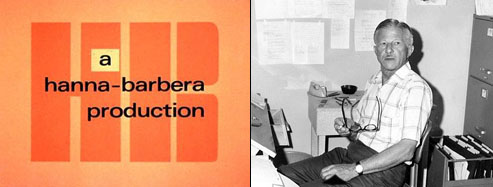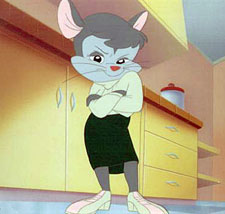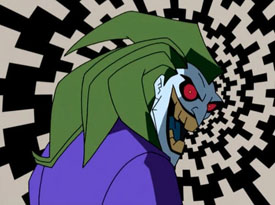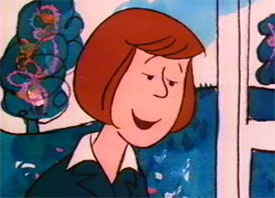
Art Babbitt at Hanna Barbera in 1969
Babbitt at H-B. In New York Times Magazine November 23rd, 1969, animation legend Art Babbitt was working as a director of commercials for Hanna-Barbera. He said, “This place is not a sweatshop in the sense that somebody stands over you with a whip but you better get your footage out. They keep very close track of everything you turn out on a picture. If you don’t turn it out, you’re fired. At a studio like this where there isn’t much difference in quality, a guy usually gets more because he’s able to turn the stuff out.
“In full animation, the mouth does not behave as a separate entity. When the mouth opens, it will effect the cheeks and jaw. When a character talks, he breathes and when he breathes, his chest expands. As his chest expands, his waist grows smaller.
“In animation here (at H-B), certain drawings work for a situation so they repeat them. But they’ve emasculated them. There’s no vitality. Also, most of these guys haven’t hefted a book or looked at good contemporary drawing in 20 years. They’ve stopped growing.”
 Stay Tuned. In The Record from July 30th, 1992, animator and producer Chuck Jones talked about an animated segment he supervised for the live action feature film Stay Tuned (1992) where John Ritter and Pam Dawber are sucked into a dangerous television world. In the animated segment they are transformed into mice battling a mechanical cat.
Stay Tuned. In The Record from July 30th, 1992, animator and producer Chuck Jones talked about an animated segment he supervised for the live action feature film Stay Tuned (1992) where John Ritter and Pam Dawber are sucked into a dangerous television world. In the animated segment they are transformed into mice battling a mechanical cat.
Jones shared directing chores with chief animator Jeff DeGrandis. Jones said, “He’s a brilliant guy and a good story man and he has the advantage of being young. (DeGrandis was in his 20s.) Of course when I started I hadn’t quite turned 19. Walt Disney was the grand old man of animation and he was 28.”
Jones designed the characters and did some 300 key drawings. Animation began six months before the live-action filming. Jones explained, “We didn’t try to caricature people as mice but we were able to use the same voices, of course, and in Pam Dawber’s case, some of the same mannerisms. It’s more like the old Warner Bros. cartoons (rather than Saturday morning) which could be enjoyed by all audiences.”
When Ritter as a cartoon mouse sends away for something from ACME, his envelope has a stamp with a caricature of Jones on it.
Burton’s Goal. In the Entertainment Weekly Fall Double Issue for 1993, filmmaker Tim Burton talking about The Nightmare Before Christmas (1993) said, “If we can disturb just one child, it will have been worth it.”
The I.B.M. Pink Panther. Few animated characters have had such a varied career as spokes-characters for such a large number of different businesses than the Pink Panther. In 1993, he was hawking I.B.M. computers in a campaign that was focused on Europe, the Middle East and Africa.
 “We basically wanted to rejuvenate the I.B.M. image of being a little bit cold, a little bit uncaring, only for big business,” said Maureen McGuire, communications manager for the company to the New York Times July 8, 1993. “The Pink Panther is warm and friendly and funny. We felt instinctively this could work very well.”
“We basically wanted to rejuvenate the I.B.M. image of being a little bit cold, a little bit uncaring, only for big business,” said Maureen McGuire, communications manager for the company to the New York Times July 8, 1993. “The Pink Panther is warm and friendly and funny. We felt instinctively this could work very well.”
“Changes in the market meant it was important to give a new face, a change of face to the I.B.M. image,” stated Nick Arnold, vice president and international client service director. “The goal was to draw on I.B.M.’s strengths while reflecting a much more sleeker, faster, friendlier, youthful image and get the human touch across.
“Testing in Europe showed that consumers believed (the Pink Panther) had important qualities that would work to I.B.M.’s advantage like that modern technology didn’t terrify him; he had humor and charm so people would be entertained whilst learning about I.B.M.’s PCs and he had class and credibility.”
The Joker Voice. Voice artist Kevin Michael Richardson was interviewed in Videoscope magazine (Spring 2017) and revealed one of his favorite performances: “The Joker from The Batman (2004, five seasons). Mark Hamill originally played the character in animation in the early ‘90s so that was a big honor for me and one of my favorite roles to do. I caught a lot of hell for it from die-hard Mark Hamill fans, as well as a lot of support, which is amazing.
 “Mark is a dear friend, so I was upset, actually, when I was asked to audition for that role because that was Mark’s role. He was wonderful. So when I was asked to audition, I had an argument with my agent. I asked, ‘Why are we doing it? It’s Mark’s job.’ Then it was explained to me that it was different producers, a different avenue they were going and all that stuff.
“Mark is a dear friend, so I was upset, actually, when I was asked to audition for that role because that was Mark’s role. He was wonderful. So when I was asked to audition, I had an argument with my agent. I asked, ‘Why are we doing it? It’s Mark’s job.’ Then it was explained to me that it was different producers, a different avenue they were going and all that stuff.
“I was so frustrated and angry and tired that I guess I put all that energy behind the microphone, and two days later they called and said I got the role. I figured I would just do the audition and go home and be done with it. I got Mark Hamill’s blessing to play that role, which meant a lot to me. He was very complimentary about it, which meant quite a lot to me because I’m a big fan of his, as well as being a friend.
“That was one of my favorite roles to do because I was nominated for a Daytime Emmy twice, which I never thought would happen.”
Happily Ever After. Happily Ever After was a PBS special that aired in October 1985. It was written by Bill Scott and directed by Bill Melendez. The film included voice work by Carol Burnett, Danny DeVito, Carrie Fisher, Henry Winkler and many more.
 The hour long animated film dealt with the subject of divorce as seen from the vantage point of the children involved. Molly, a take-charge 9-year-old, has vivid dreams about being the ”princess of the high wire” in a daring circus act. She has a big imagination and a big problem.
The hour long animated film dealt with the subject of divorce as seen from the vantage point of the children involved. Molly, a take-charge 9-year-old, has vivid dreams about being the ”princess of the high wire” in a daring circus act. She has a big imagination and a big problem.
When her parents tell her they have a big announcement, she assumes it is a baby and not a divorce announcement. From being a bright, involved student she becomes distracted and shy wondering if she had done something wrong or not done something. In her dreams, she now tumbles off the high wire.
Cassandra Coblentz was lauded for her voice work as Molly.
Melendez noted that animation was the best way to tackle the divorce theme “because live action would be too real.” He called the project a “labor of love” for everyone involved. A sequel, Two Daddies?, was produced in 1989.
(My thanks to Chris Sobieniak for his assistance in locating video for this weeks post)


 Jim Korkis is an internationally respected animation historian who in recent years has devoted his attention to the many worlds of Disney. He was a columnist for a variety of animation magazines. With his former writing partner, John Cawley, he authored several animation related books including The Encyclopedia of Cartoon Superstars, How to Create Animation, Cartoon Confidential and Get Animated’s Animation Art Buyer’s Guide. He taught animation classes at the Disney Institute in Florida as well as instructing classes on acting and animation history for Disney Feature Animation: Florida.
Jim Korkis is an internationally respected animation historian who in recent years has devoted his attention to the many worlds of Disney. He was a columnist for a variety of animation magazines. With his former writing partner, John Cawley, he authored several animation related books including The Encyclopedia of Cartoon Superstars, How to Create Animation, Cartoon Confidential and Get Animated’s Animation Art Buyer’s Guide. He taught animation classes at the Disney Institute in Florida as well as instructing classes on acting and animation history for Disney Feature Animation: Florida.




















































Happily Ever After was the last project that Bill Scott worked on before his untimely death in 1985. He also did the voice of the school janitor in Happily Ever After. Happily Ever After was decdicated to his memory.
The character designs on every non-Peanuts project Bill Melendez tackled all seem to look like Peanuts one generation removed.
Interestingly, Bill Melendez never seemed to establish a visual style of his own. The style that he established in his non-Peanuts stories might have solidified from having made Peanuts adaptions the bread-and-butter of his output.
His style tended to focus less on graphics than on the subject matter, which touched upon modern, progressive issues. This could arguably have been Melendez’s takeaway from the school of UPA.
Especially true in that lamentable “Romance of Betty Boop,” where many characters looked more Schulz than Fleischer.
His style tended to focus less on graphics than on the subject matter, which touched upon modern, progressive issues. This could arguably have been Melendez’s takeaway from the school of UPA.
I suppose the UPA background he had, combined with the need to relate modern, progressive issues, was what made his work stood out from the rest in the long run, regardless of the sort of Peanuts influence that developed along the way. It’s especially apparent in examples like Happily Ever After to see how design (a surface element) is far less interesting than it is for the emotions and struggles of its characters (the meat).
Was it really a bad thing that the kids looked like the Peanuts gang? I don’t think so.
Besides, I recall Melendez also did the animated adaption of “The Lion, The Witch, and The Wardrobe”, where the designs of the kids looked completely different than “Peanuts” and looked rather inferior as a result.
“That’ll put a crease in his shorts”
😀
Underrated CJ segment
The animated sequence in “Stay Tuned” has the feel of a Tiny Toons episode, largely due to Bruce Broughton working on both things and exhibiting similar orchestrations.
I mainly know Jeff DeGrandis from his work on the Ren & Stimpy-inspired “Shnookums and Meat”, where he and Bill Kopp really cut loose and broke from the Disney mold with some truly deranged animation.
Reading that Babbit quote, does anyone know what the required minimum footage per week at Hanna-Barbera in the 1960s/70s was?
Oh yeah, Stay Tuned! I originally bought the DVD just to have the animated segment in my collection, in good quality. I was surprised to find the film being good as a whole. Bought the Blu-Ray this year.